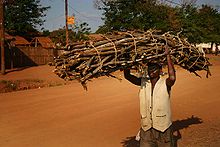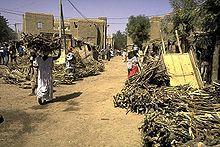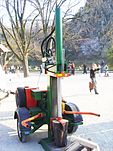Firewood


Firewood is any wooden material that is gathered and used for fuel. Generally, firewood is not highly processed and is in some sort of recognizable log or branch form, compared to other forms of wood fuel like pellets or chips.
Firewood is a renewable resource. However, demand for this fuel can outpace its ability to regenerate on local and regional level. For example in some places in the world and through history, the demand has led to desertification[citation needed]. Good forestry practices and improvements in devices that use firewood can improve the local wood supplies.
Firewood terms
Since firewood has been used by humans for a long time, there are many terms and concepts to describe it.
North America
Firewood can either be seasoned (dry) or unseasoned (green). It can be classed as hardwood or softwood. In most of the United States, the standard measure of firewood is a cord or 128 cubic feet (3.6 m3), however, firewood can also be sold by weight. The BTU value can have an impact upon the price.
Harvesting

Harvesting or collecting firewood varies by the region and culture. Some places have specific areas for firewood collection. Other places may integrate the collection of firewood in the cycle of preparing a plot of land to grow food as part of a field rotation process. Collection can be a group, family or an individual activity. The tools and methods for harvesting firewood are diverse.
North America
Some firewood is harvested in "woodlots" managed for that purpose,[1] but in heavily wooded areas it is more usually harvested as a byproduct of natural forests. Deadfall that has not started to rot is preferred, since it is already partly seasoned. Standing dead timber is considered better still, as it is both seasoned and has less rot. Harvesting this form of timber reduces the speed and intensity of bushfires. Harvesting timber for firewood is normally carried out by hand with chainsaws. Thus, longer pieces - requiring less manual labour, and less chainsaw fuel - are less expensive and only limited by the size of their firebox. Prices also vary considerably with the distance from wood lots, and quality of the wood. Buying and burning firewood that was cut only a short distance from its final destination prevents the accidental spread of invasive tree-killing insects and diseases.[2][3] Generally speaking, a distance of 50 miles (80 km) from cut site to final burning site is considered[by whom?] the longest distance that firewood should be moved. Normally wood is cut in the winter when trees have less sap so that it will season more quickly.
Preparing
In most parts of the world, firewood is only prepared for transport at the time it is harvested. Then it is moved closer to the place it will be used as fuel and prepared there. The process of making charcoal from firewood can take place at the place the firewood is harvested.
Most firewood also requires splitting, which also allows for faster seasoning by exposing more surface area. Today most splitting is done with a hydraulic splitting machine, but it can also be split with a splitting maul. More unusual, and dangerous, is a tapered screw-style design, that augers into the wood, splitting it, and can be powered by either a power take-off drive, a dedicated internal combustion engine, or a rugged electric pipe-threading machine, which is safer than the other power sources because the power can be shut off more easily if necessary.
Storing



There are many ways to store firewood. These range from simple piles to free-standing stacks, to specialized structures. Usually the goal of storing wood is to keep water away from it and to continue the drying process.
Stacks: The simplest stack is where logs are placed next to and on top of each other, forming a line the width of the logs. The height of the stack can vary, generally depending upon how the ends are constructed. Without constructing ends, the length of the log and length help determine the height of a free-standing stack.
There is debate as whether wood will dry quicker when covered. There is a trade off between the surface of the wood getting wet and allowing as much wind and sun as possible to access the stack. This cover can be almost any material – a large piece of plywood, sheet metal, terracotta tiles, or an oiled canvas cloth, even cheap plastic sheeting may also be used. Wood will not dry when completely covered. Ideally pallets or scrap wood should be used to raise the wood from the ground, reducing rot and increasing air flow.
There are many ways to create the ends of a stack. In some areas, creating a crib end by alternating pairs of logs helps stabilize the end. A stake or pole placed in the ground is another way to end the pile. A series of stacked logs at the end, each with a cord tied to it and the free end of the cord wrapped to log in the middle of the pile, is another way.
Under a roof: There are no concerns about the wood being subjected to rain, snow or run-off. The methods for stacking depend on the structure and layout desired. Whether split, or in 'rounds' (flush-cut and unsplit segments of logs), the wood should be stacked lengthwise, which is the most stable and practical method. Again though, if the wood needs further seasoning there should be adequate air flow through the stack.
Storing outdoors: Firewood should be stacked with the bark facing upwards. This allows the water to drain off, and standing frost, ice, or snow to be kept from the wood.
Round stacks can be made many ways. Some are piles of wood with a stacked circular wall around them. Others like the American Holz Hausen are more complicated.
- A Holz hausen, or "wood house", is a circular method of stacking wood; proponents say it speeds up drying on a relatively small footprint. A traditional holz hausen has a 10-foot diameter, stands 10 feet high, and holds about 6 cords of wood. The walls are made of pieces arranged radially, and tilted slightly inward for stability. The inside pieces are stacked on end to form a chimney for air flow. The top pieces are tilted slightly outward to shed rain and are placed bark side up.[4]
Heating value of firewood

The moisture content of firewood determines how it burns and how much heat is released. Unseasoned (green) wood moisture content varies by the species; green wood may weigh 70 to 100 percent more than seasoned wood due to water content. Typically, seasoned (dry) wood has 20% to 25% moisture content. Use of the lower heating value is advised[5] as a reasonable standard way of reporting this data.
The energy content of a measure of wood depends on the tree species.[6] For example, it can range from 15.5 to 32 million British thermal units (16.4 to 33.8 GJ) per cord.[7] The higher the moisture content, the more energy that must be used to evaporate (boil) the water in the wood before it will burn. Dry wood delivers more energy for heating than green wood of the same species.
Here are some examples of energy content of several species of wood:
| Wood Species | Heat Value per Cord |
|---|---|
| Tamarack | 22.3 MMBtu (23.5 GJ) |
| Birch | 21.3 MMBtu (22.5 GJ) |
| Red Fir | 20.6 MMBtu (21.7 GJ) |
| White Fir | 16.7 MMBtu (17.6 GJ) |
The Sustainable Energy Development Office (SEDO), part of the Government of Western Australia states that the energy content of wood is 4.5 kWh/kg or 16.2 gigajoules/tonne (GJ/t).[8]
Measurement of firewood


Usually firewood is sold by volume. While a specific volume term may be used, there can be a wide variation in what this means and what the measure can produce as a fuel. For example, a cord which is made from 4-foot (1.22 m) logs, will not be a cord when it is cut into 1 foot logs and these split so each piece will fit through a 3-inch (7.6 cm) circle. A measure of green unseasoned wood with 65% moisture contains less usable energy than when it has been dried to 20%. Regardless of the term, firewood measurement is best thought of as an estimate.
Metric
In the metric system, firewood is usually sold by the stère. One stère measure one metre high by one metre wide by one metre long and has a volume of 1 cubic meter (1 cubic meter or 0.276 cords). The most common firewood piece length are 33 cm and 50 cm. As a remnant of the pre-metric systems, 3 stères are sometimes called a "Corde" in France. Wood can also be sold by the kilogram or by the metric tonne, as in Australia.
North America
In the United States and Canada, firewood is usually sold by the full cord, face cord or bag.
- A full cord or bush cord has a volume of 128 cubic feet (3.6 m3), including wood, bark, and air space in a neatly stacked pile.[9] The actual wood volume of a cord may be in the range of 80 to 100 cubic feet (2.3 to 2.8 m3) as stacked wood takes up more space than a piece of solid wood. The most common firewood piece length is 16 inches (41 cm).[10]
- A face cord is one third of a full or bush cord stack of wood that is 4 by 8 ft (1.22 by 2.44 m) by 16 in (41 cm) and has a volume of 42.6 cubic feet (1.21 m3).[10]
In popular culture
In Norway, the non-fiction book Hel Ved (In English: Solid Wood: All About Chopping, Drying and Stacking Wood — and the Soul of Wood-Burning) by Lars Mytting became a bestseller in 2011/2012, selling 150 000 copies. A version of the book has also been published in Sweden, selling 50 000 copies.[11]
In February 2013, the Norwegian state broadcast NRK sent a 12 hour live program on the topic of woodfire, where a large part of the program consisted of showing firewood burning in a fireplace. More than one million people, 20% of Norway´s population, saw part of the program.[12]
See also
References
- ^ Where does firewood come from?
- ^ Dontmovefirewood.org
- ^ Don't move firewood - CFIA
- ^ How to construct a Holz Hausen
- ^ "Firewood Storage Racks - Wood Covers". Firewood Rack. Retrieved 2010-07-29.
- ^ Energy Content of Firewood
- ^ Preparing your fuel supply
- ^ "Office of Energy - Clean Energy". Sedo.energy.wa.gov.au. 2010-01-01. Retrieved 2010-07-29.
- ^ "Buying Firewood? Don't Get Burned!". Measurement Canada. Retrieved 2013-08-15.
- ^ a b "What is a Cord? And How to Avoid Paying Too Much for One". Woodheat.org. Retrieved 2013-08-16.
- ^ Norsk ved-TV vekker oppsikt i USA Aftenposten, February 20, 2013
- ^ Sarah Lyall: Bark Up or Down? Firewood Splits Norwegians New York Times, February 19, 2013
External links
- At "Wood stove & energy" is a free online tool available to calculate the heating power of different types of wood at different moisture contents.
- Website which compares qualities of American wood species in cord measurements.


